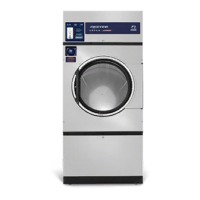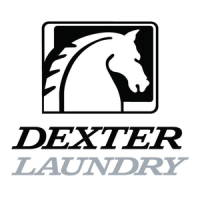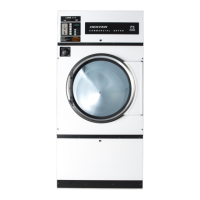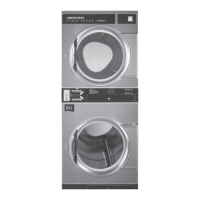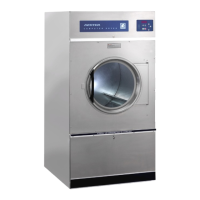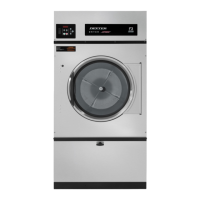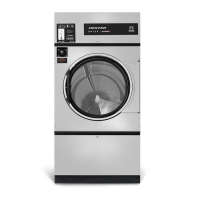20
GAS REQUIREMENTS.
The complete gas requirements necessary to operate the dryer satisfactorily are listed on the serial plate
located on the back panel of the dryer. An individual gas shuto valve is recommended for each dryer
and may be required by local code (not supplied). The inlet gas connection to the unit is 1/2 inch [12.7]
pipe thread for T-30/50 and 3/4 inch [19.1] for the T-80/T-120. A joint compound resistant to the action
of liqueed petroleum gases should be employed in making pipe connections. A 1/8 inch NPT plugged
tapping, accessible for test gage connection, must be installed immediately upstream of the gas supply
connection to the dryer. A drip tee should be provided in the gas piping entering the unit to catch dirt and
other foreign articles. All pipe connections should be checked for leakage with soap solution. Never check
with an open ame. The recommended natural gas supply pressure is 7 inches water column (17.8 cm) at
each dryer.
With the burners in operation, check the gas pressure at the threaded port in the end of the burner
manifold. Adjust the dryer’s gas control valve for 3.5 inches water column (8.89 cm w.c.) pressure at the
manifold (Adjust T-30 -39 models to 3.4 in. w.c. (8.64 cm w.c.)).
For altitudes above 2,000 feet (610m) it is necessary to de-rate the BTU input. Contact your local distribu-
tor for instructions. L.P. gas conversion kits are available for this dryer. Contact your local distributor.
CAUTION: The dryer must be disconnected from the gas supply piping system during any pressure test-
ing of that system. Do not expose the dryer’s gas control valve to testing pressure.
Burner Set-Up
All gas burner manifolds should be checked for proper gas pressure while burning. Dryer manifold
pressure should be set at 3.5 W.C. for Natural Gas while burner operating.
EXHAUST INSTALLATION. (Refer to Figure 2 at the end of section 6.)
Exhausting of the dryer(s) should be planned and constructed so that no air restrictions occur. Any re-
striction due to pipe size or type of installation can cause slow drying time, excessive heat, and lint in the
room.
From an operational standpoint, incorrect or inadequate exhausting can cause a cycling of the high limit
thermostat which shuts o the main burners and results in inecient drying.
Individual exhausting of the dryers is recommended. All heat, moisture, and lint should be exhausted
outside by attaching a pipe of the proper diameter to the dryer adapter collar and extending it out through
an outside wall. This pipe must be very smooth on the inside, as rough surfaces tend to collect lint which
will eventually clog the duct and prevent the dryer from exhausting properly. All elbows must be smooth
on the inside. All joints must be made so the exhaust end of one pipe is inside the next one downstream.
The addition of an exhaust pipe tends to reduce the amount of air the blower can exhaust. This does
not aect the dryer operation if held within practical limits. For the most ecient operation, it is recom-
mended that no more than 14’ (4.3m) of straight (8” (20.3cm) for T-30/50/80, 10 or 12” (25.4 or 30.5cm)
for T-120) diameter pipe be used with two right angle elbows. When more than two elbows are used,
2’ (61cm) of straight pipe should be removed for each additional elbow. No more than four right angle
elbows should be used to exhaust a dryer.
Maintain minimum 1” (25) clearance between duct and combustible material.
If the exhaust pipe passes through a wall, a metal sleeve of slightly larger diameter should be set in the
wall and the exhaust pipe passed through this sleeve. This practice is required by some local codes and
is recommended in all cases to protect the wall. This type of installation should have a means provided to
prevent rain and high winds from entering the exhaust when the dryer is not in use. A hood with a hinged
damper can be used for this purpose. Another method would be to point the outlet end of the pipe down-
ward to prevent entrance of wind and rain. In either case, the outlet should be kept clear, by at least 24”
(610), of any objects which would cause an air restriction.
Part # 8533-112-001 7/21
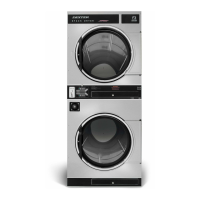
